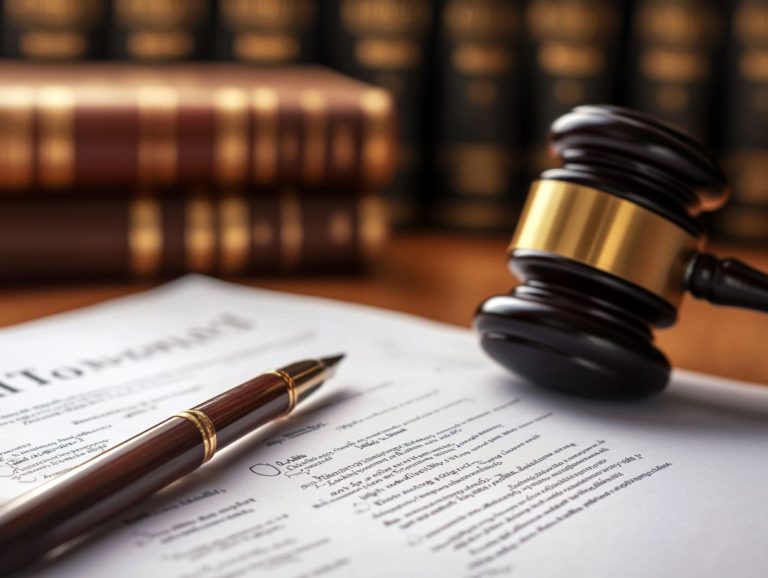The Connection Between Licensing Agreements and Copyright
Navigating the complex landscape of creative work can be quite challenging, especially when it comes to understanding licensing agreements and copyright.
This article distills the essentials for you, starting with clear definitions and the basic principles of copyright. It explores how licensing agreements serve as protective tools for copyright holders, outlining their key components and benefits.
You ll also find potential challenges addressed, offering a well-rounded perspective on this crucial aspect of creative ownership. Join us as we simplify these important concepts together.
Contents
- Key Takeaways:
- Understanding Licensing Agreements
- Copyright Basics
- The Relationship Between Licensing Agreements and Copyright
- Benefits of Licensing Agreements for Copyright Holders
- Potential Issues with Licensing Agreements
- Frequently Asked Questions
- What is the connection between licensing agreements and copyright?
- Are licensing agreements necessary for the use of copyrighted material?
- What is the purpose of a licensing agreement?
- What are some common types of licensing agreements?
- How do licensing agreements benefit both parties involved?
- What happens if a licensing agreement is violated?
Key Takeaways:

- Licensing agreements let someone use copyrighted material for payment and specific conditions.
- Copyright protects creators’ rights, keeping their works safe from unauthorized use.
- Licensing agreements provide copyright holders with a way to safeguard their work and earn income, though they can also present challenges regarding control and compensation.
Understanding Licensing Agreements
Licensing agreements are crucial legal frameworks that regulate the use of creative work. They allow you to utilize copyrighted material while ensuring that the original creator retains ownership and control over their artistic works. To delve deeper, it’s important to consider understanding the implications of licensing agreements.
These agreements play a vital role in managing copyrights, patents, and trademarks. They enable creators to monetize their work through various licensing structures, including both exclusive and nonexclusive licenses, and understanding the relationship between patents and copyrights is crucial in this process.
By understanding these agreements, you can effectively navigate the complexities of the contract lifecycle, royalty fees, and dispute resolution. This ultimately encourages fruitful collaborations within the creative industries.
Definition and Purpose
Licensing agreements are legally binding contracts that outline the specific terms under which you, as the licensee, can use creative work owned by another party, known as the licensor.
These agreements are essential for protecting rights linked to copyrights, patents, and trademarks. They ensure that the licensor maintains control over how their creations are used. By establishing clear boundaries, they help prevent unauthorized use, infringement, and potential legal disputes.
It’s essential for anyone involved in drafting these agreements to seek legal advice. Navigating the intricacies of creative work law can be daunting. Legal counsel can provide insights into the implications of each term and condition, ensuring that both parties are protected and that the agreement complies with relevant laws.
Copyright Basics
Copyright is a legal principle that grants you exclusive rights to your original creations, including books, music, photography, or films.
This protection ensures that your creative expressions are safe from unauthorized use and reproduction, allowing you to maintain control over your intellectual property.
What is Copyright?
Copyright is a vital form of legal protection that safeguards your original works of authorship, such as art, literature, music, and software.
This legal framework has evolved significantly since its beginnings, traced back to the Statute of Anne in 1710 in England, which aimed to give authors control over their creations.
As technology and creativity advanced through the centuries, copyright laws adapted accordingly, responding to societal needs and the emergence of new mediums.
In today’s world, copyright is crucial in the creative industries. It not only protects your rights as a creator but also fosters innovation.
By ensuring that you can reap financial rewards from your works, copyright encourages the development of fresh ideas and artistic expressions, creating a vibrant environment where creativity can thrive.
How Does it Work?

Copyright enables you by granting exclusive rights to reproduce, distribute, and display your artistic works. You can also allow others to use these rights, collecting royalties or copyright fees in the process.
This legal framework ensures that you retain control over how your work is utilized, allowing for negotiations with those who wish to use your content for various purposes.
To obtain a copyright, you’ll need to register your work with the appropriate governmental office. This not only solidifies your ownership but also provides legal recourse should infringement occur.
As someone who gains permission to use the work (the licensee), you acquire rights under agreed terms, which may include restrictions on duration, geographic scope, and purpose.
For creators like you, entering into licensing agreements can be a smart strategy to generate income while still maintaining rights over your original creation, all while establishing clear boundaries to protect your intellectual property.
The Relationship Between Licensing Agreements and Copyright
Licensing agreements are your key to unlocking exciting opportunities, acting as a crucial bridge between copyright holders and those eager to use copyrighted materials. Understanding the relationship between licensing agreements and trade marks can further enhance these opportunities.
They enable you, the licensee, to access valuable intellectual property while honoring the rights of the person who owns the work (the licensor).
How Licensing Agreements Protect Copyright
Licensing agreements serve as a shield for copyright, clearly outlining the terms of use to ensure you, as the licensee, adhere to the legal parameters set by the licensor. Understanding the relationship between licensing agreements and trade secrets helps you avoid any unauthorized exploitation of valuable intellectual property.
Within these agreements, you ll find specific clauses detailing your usage rights, granting you permission to utilize the copyrighted material in accordance with carefully stipulated conditions.
Confidentiality clauses play a vital role here, mandating that any proprietary information exchanged during the licensing process remains secure. This protects against misuse or leaks that could jeopardize the licensor’s interests.
Effective dispute resolution mechanisms are crucial. They establish procedures for addressing any conflicts that may arise, ensuring a fair and efficient means of resolving issues without the need for drawn-out legal battles.
Common Elements of Licensing Agreements
Common elements of licensing agreements include the identification of both the licensee and the licensor, the scope of the license granted, royalty fees, duration, and conditions of use.
These crucial components come together to establish a clear framework that governs the relationship between the parties involved. The identification aspect ensures that both you, the licensee who receives the rights, and the licensor who retains ownership, are clearly defined, preventing any potential confusion.
The scope of the license explicitly outlines what rights are being transferred, whether it s confined to specific geographical areas or particular product categories. Royalty fees play a vital role as a compensation mechanism for the licensor, reflecting the inherent value of the licensed material.
The duration clause stipulates how long the agreement will remain valid, ensuring both parties fully understand the timeline. Conditions of use impose guidelines for you as the licensee, safeguarding the licensor s rights and promoting ethical usage.
Together, these elements facilitate effective contract management, promoting transparency while protecting the interests of both parties.
Benefits of Licensing Agreements for Copyright Holders
Licensing agreements offer a wealth of advantages for copyright holders. They enable you to monetize your artistic creations, allowing you to maintain control over your intellectual property while generating a steady stream of revenue through royalties and copyright fees. Understanding the legal implications of licensing agreements is crucial to maximizing these benefits.
This strategic approach not only enhances your financial prospects but also safeguards the integrity of your work. Now is the perfect time to explore licensing agreements to boost your revenue!
Monetary Compensation and Control

Monetary compensation through licensing agreements enables you, as a copyright holder, to earn royalty fees while maintaining control over how your works are utilized and distributed. This setup lets you negotiate in ways that work best for you, whether that s flat fees, percentage royalties, or milestone payments tied to sales targets.
For example, in the entertainment industry, successful licensing deals often see established brands lending their beloved characters to various merchandise or media projects.
By strategically leveraging your rights, you can create lucrative opportunities. This transforms your intellectual properties into profitable ventures and explores untapped markets.
Ultimately, understanding these details can unlock incredible financial opportunities while preserving your artistic integrity.
Potential Issues with Licensing Agreements
Despite the numerous advantages, licensing agreements can introduce potential challenges. To address these issues, it’s important for both copyright holders and licensees to understand trademark licensing agreements and navigate these challenges effectively.
These issues may include difficulties in enforcement, restrictions on usage, and the necessity for robust dispute resolution mechanisms.
Challenges and Limitations
Challenges in licensing agreements often arise when the terms lack clarity. This can lead to conflicts between you, the licensee, and the licensor regarding the use of copyrighted material.
You might find yourself mistakenly interpreting what qualifies as ‘non-commercial use,’ convinced that your intended application fits within those parameters, when it actually does not.
Misunderstandings can also emerge around royalty payments. Unclear percentage calculations or reporting timelines can lead to disputes, straining valuable relationships.
Copyright law varies by country, adding complexity. If you’re operating in one region, you may discover that a term accepted in your home jurisdiction is not recognized elsewhere.
This can lead to legal quandaries that hinder your business operations and diminish the anticipated benefits of your agreement.
Frequently Asked Questions
What is the connection between licensing agreements and copyright?
The connection between licensing agreements and copyright is that licensing agreements are legal contracts that grant permission to use a copyrighted work. These agreements outline the terms and conditions for the use of the copyrighted work, including how it can be used, by whom, and for how long, highlighting the interconnection of licensing agreements and IP rights.
Are licensing agreements necessary for the use of copyrighted material?

Yes, the process of licensing copyrighted works is necessary for the use of copyrighted material. These agreements help protect the rights of the copyright owner and ensure fair compensation for the use of their work.
What is the purpose of a licensing agreement?
The purpose of a licensing agreement is to outline the terms and conditions for the use of a copyrighted work. This includes details such as the scope of use, payment terms, and any restrictions on the use of the work.
What are some common types of licensing agreements?
Some common types of licensing agreements include music licenses, software licenses, patent licenses, and trademark licenses. These agreements vary depending on the type of copyrighted work being licensed.
How do licensing agreements benefit both parties involved?
Licensing agreements benefit both parties by providing a clear understanding of the rights and responsibilities of each party. The copyright owner receives compensation for the use of their work, while the licensee obtains the necessary permission to use the work without fear of copyright infringement. Understanding the connection between trademarks and copyrights can further enhance these agreements.
What happens if a licensing agreement is violated?
If a licensing agreement is violated, the copyright owner has the right to take legal action against the violator. This can result in monetary damages or an injunction to stop the unauthorized use of the copyrighted material.






